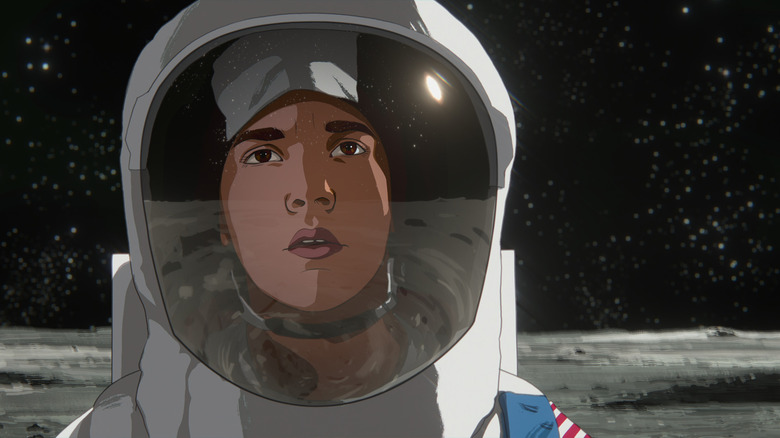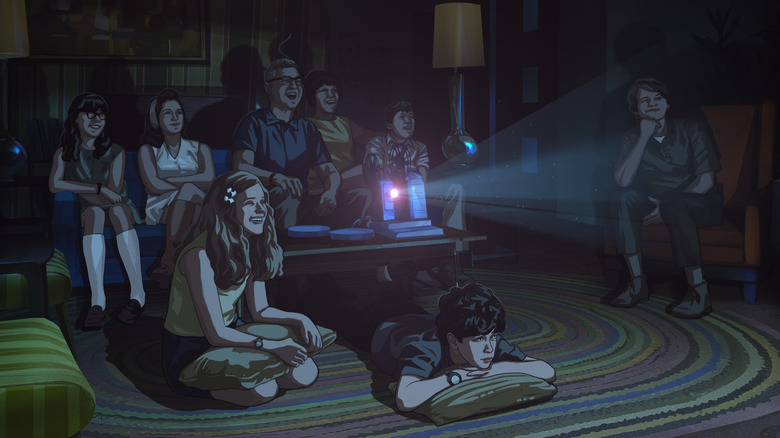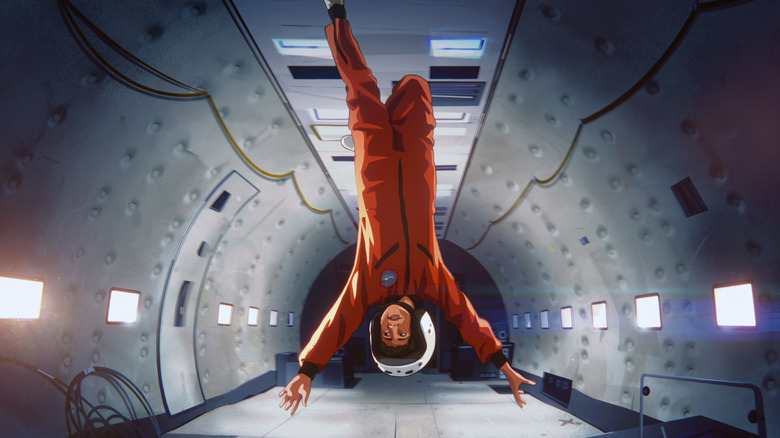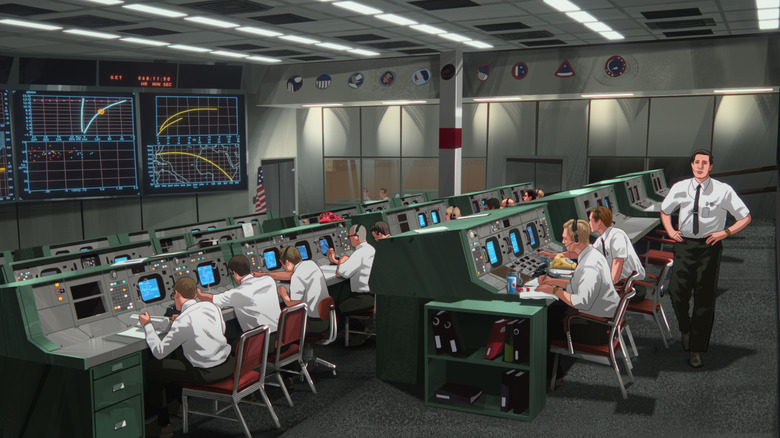Richard Linklater And Glen Powell Talk Apollo 10 1/2 And Recreating 1960s Houston In Animation [Interview]
Richard Linklater has returned to animation with a slice-of-life sci-fi adventure film that takes us back in time to 1960s Houston. It was a time when the world was on fire, war was raging, and people were still excited about the latest technology and TV show — so, nothing like today.
"Apollo 10 1/2" is Linklater's first rotoscope animated film since "A Scanner Darkly," but this is unlike anything the director has done before. The animation compliments the story by molding the fuzzy memories of childhood and mixing reality and fiction, with motion captured live-action performances played under layer after layer of animation. The result is a heartwarming, exciting, funny coming-of-age animated film.
Ahead of the film's world premiere at SXSW, I was able to sit with Linklater and star Glen Powell to talk about the movie, animation, and being a kid who isn't aware of how awful things are around you.
'I wanted the realism of the characters'
When did you decide to use animation to make the film?
Linklater: I was thinking live-action, because that's my default mode, probably. But then somewhere along the way, I started thinking animation was the way it should work in the head of the viewer. It smoothed everything out, made the fantasy more real and the real more fantasy. And it just kind of worked. Live-action's so literal and it wasn't quite working in my head like that. And there's a practical edge, too. It would probably cost a hundred million dollars, which no one's going to give me. I guess it doesn't even need be stated, that no one's going to give me a hundred million dollars to make a film about a bunch of families sitting around watching TV.
It's not just animation, but rotoscope, which is not a technique we see often. What excited you about working with that format?
Linklater: Well, this is very different than "A Scanner Darkly" and "Waking Life," my two previous films that are rotoscope movies, which means you design the movies, you shoot it, and then you kind of draw everything. This, we're shooting it on a green screen and we're animating every anything else. It's more of a 2D with 3D elements and rotoscope for the characters, just the outline of the characters because they're colored and shaded and everything is in a more traditional animation process. It's a different process, but for a different film. I didn't want it to look like that entirely, but I wanted the realism of the characters. That's just a technique I'm very familiar with and my head of animation, Tommy Pallotta, we've been working together for years. The animation was so fun. It was just such a challenge to make a period film, try to get that look, those colors, that texture, and then we had all the kind of different mediums, too. You could say documentary. There's footage of TV footage. It's fun to animate. What's really fun is we have a brief section in there of Saturday morning cartoons, Bugs and Daffy, but to be animating and animate something that's already animated, that's pretty fun. To be animating TV, which you kind of process as animated anyway, it was so wild to be reinterpreting "The Wizard of Oz." It's so cool to see the monkeys in animation. To pull these things we all share collectively in our memories, but to put it into our own animated world here, it was kind of meta.
Powell: [to Linklater] Can I ask you a question? While we were shooting it, I was wondering about the lighting sources, we didn't change lights around that much.
Linklater: Not that much. You light in animation. You can kind of pick where the light's coming in, the shading, shadows, light, where all that is located.
Are you thinking about lighting while you're shooting, or does that come in later?
Linklater: Well, you've got to think about it a little bit before. Just a general lighting, key light, your source, you just have a lighting plan, and then you just got to capture the image. But just a lot of that's done in post. For mission control, we knew when we were shooting that day exactly what that room was going to look like, but we just hadn't built it yet in animation. A lot of this in the animation we had to just kind of invent as we went, but I do everything a lot that way, just confident like, "Oh we'll get there. We'll figure out how to do it." And I was working with people who are like, "Yeah, I think we can do that. We'll figure it out." I knew I was in trouble when I would look up, because every shot in the movie's a special effect basically, because it's all dialed in, already pre-visualized, but if I would start moving the camera too much, I'd look up and Tommy and Mattias, the animation guys who were on set, they'd be like, "If you do that ..." And I'd be like, "OK, OK." So we were always checking and balancing each other, because I knew we had limited time and money.
'People were sending us their home movies and photos'
Glen, did you take the fact you'd be animated into consideration for your performance?
Powell: Honestly, it felt like we were just, again, shooting something that happened to just be on green screen. But I think everything was pretty dialed in. Nothing felt like we had to change performances for a thing.
Linklater: You don't go, "Well, remember you're playing an animated character." (laughs)
Powell: (laughs) "Now, what would I do here?"
Linklater: We're going for utter realism. It's no different than a live-action movie.
Powell: I actually find some of my favorite performances in the movie are very dialed in and very naturalistic. And I think that with this animation style mixed with those performances, I'm actually like, "Oh my God, it really works in a different way than in any other style." Because I think in other styles, the performances do get a little bigger. The physical comedy becomes more of a thing.
Linklater: But usually that's the story anyway, if you're making a film about singing animals or something, that's great, but realism's not on the table. But there's not a lot of period film realism. It's not the demands of most animated films.
Glen, you've already played one astronaut before. What sort of research of preparation do you do to get into the role in this film?
Linklater: Well, Glen had a jump. He'd already played John Glenn in one movie. All he had to do was walk over to mission control.
Powell: Yeah, and I was home. But I got to say that's, that's another really incredible thing to see in the movie. The fact that we are in the stage in Austin Studios and there's really not much there. It's basically these green sort of ... what would you call them?
Linklater: Consoles with monitors. Anything you touched, if you had to interact, if you had to drink, anything real [there were props]. But at the house, it was just the chairs and tables, but the walls and things, unless you're touching it, we animate that. It was fun. But the movie, to get all those details right, we researched this for years leading up to it. Even as I was writing it, we took just a lot of exact transcripts of the space thing, all the transcripts from the TV. It's a big TV production, right? Just an incredible TV production of what the moon landing was. CBS, especially — Walter Cronkite, our country's leading news anchor, really, he was just at the top of his game, you can tell he loved this all so much. And they did their research. It was incredible. It informed me so much, just going through the archival stuff. They did a great job incorporating that. Because I wanted to be like, "OK, Stan's doing this, but we're not saying there's a camera on the moon." We'll cut to the TV, like "simulation," like we're the family's point of view. It gets confusing. I was like, "No, the family's watching TV. Stan's seeing it out the window, but they're watching it." So the images would come in, and I'd be like, "No, that's not Stan's point of view, that's the TV simulations." There was a couple layers. It was always kind of like, "OK, what are we doing here?" Yeah. It was, it was very complex, actually.
How about the sort of day-to-day life, and recreating Houston in the '60s?
Linklater: As we headed in, yet one more contributing factor in the live-action was, "Well, they tore down Astroworld a while back, how are we going to shoot in that? I don't think they'll let us build an amusement park for this movie." But it was kind of easy. We sort of crowdsourced a lot of images. We kind of put out the word in Houston through their local media — this is years ago — people were sending us their home movies and photos.
A lot of those home movies, some are actually in the movie, and then some are just references. I could tell my animators, "See that s***** looking home movie? That's the Black Dragon, the ride." They could look at that and go "That's the Astroneedle," and then I was just remembering, "No, here's how it was." I've spent the whole animation process just trying to be as specific as possible with people in Amsterdam who had no f****** idea of what a Little League outfield is. "No, you're playing right field or second, but you're not in between," and they had no idea what I'm talking about. But I could explain those things because I lived them.
'I didn't want it to be some rose-colored glasses, overly nostalgic piece'
Something I loved about the movie was that it balanced this sort of excitement for the future and the Space Age, while also showing that things were pretty bleak. Can you talk about balancing those tones?
Linklater: That's one of my biggest memories and what I wanted to kind of share in this movie was those two things. Because people look back on the past, it's always so clear. "Oh, with space, everything's positive." I'm like, "Kind of isn't." It always is and it isn't. I was really trying to capture that in a kid's mind, where you don't quite understand the adult world.
Because I remember as a kid, just my door would open and my sister would say, "Kennedy got shot last night." I'm like, "Wait, that was like a long time ago, right?" "No. Robert Kennedy." I'm like, "Oh f***. He got shot?" It's like, "Oh, there's a war? Oh, the Russians invaded Czechoslovakia? What? Oh..." You turn on the TV and towns are on fire. Like, "What the f***?"
Then you had the environmental movement had really kicked in — littering, like the movie says, there was a full-scale warning, I guess, to the culture about water, air, everything. Which is good. It helped. But as a kid, it's a little scary. But still, it's fun to be a kid, no matter where you are. And there was so much to be excited about. I don't know. It just depends on where you, where you point it. But I don't remember it being — it was just concern. "Am I going to go fight in the war?" You're just trying to figure out the world. It's kind of interesting that moment before you technically even can.
I was more sure of my NASA knowledge and stuff from science class. I felt that was tangible, where the world around me was very volatile. I mean, not in my neighborhood — it was fine in the suburbs of Houston. But the outer world that you got signals from seemed pretty chaotic. There's a lot of dissonance in the old youthful brain and I didn't want it to be some rose-colored glasses, overly nostalgic piece. I had just enough broken bones or whatever to kind of keep that real. Still, it was a good time, but people rear their children differently now. Very much so.
"Apollo 10 1/2" hits Netflix on April 1, 2022.



